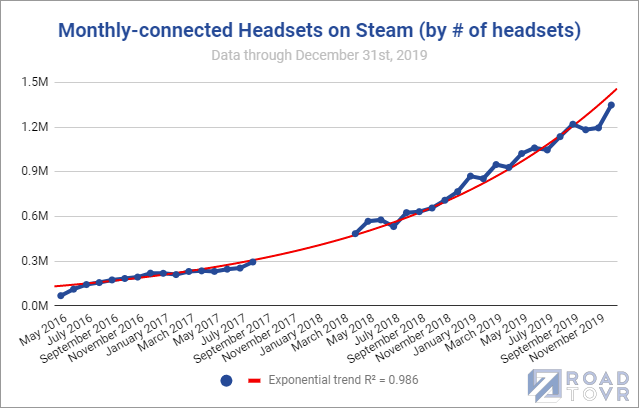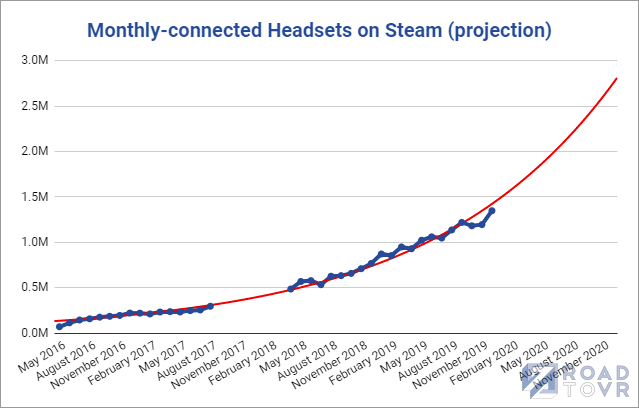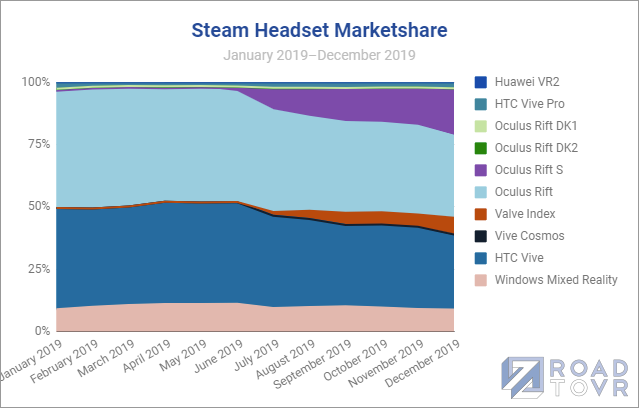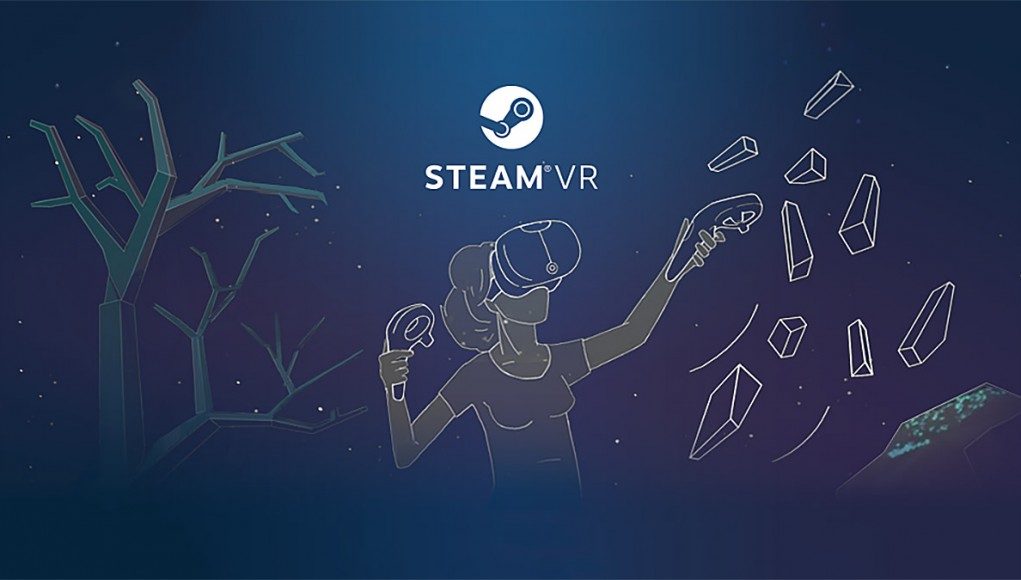Valve’s monthly Steam Survey has long offered useful insight into the share of VR headsets in use on Steam. But the figures provided are relative to the non-static Steam population, which obfuscates the actual adoption trend of VR headsets on the platform. To demystify the data, Road to VR has developed a proprietary model which derives actual headset counts by correcting for Steam’s changing population. The latest data shows that monthly-connected VR headsets on Steam have reached a record high of 1.3 million in December.
Introduction
Each month Valve collects info from Steam users to determine some baseline statistics about what kind of hardware and software is used by the platform’s population, and to see how things are changing over time; that includes which VR headsets are connected to users’ computers. Participation in the survey is optional, and headsets aren’t counted if they aren’t powered on and recognized by Steam at the moment that the data is collected.
Data is captured over the course of the month, which tells us how many headsets were connected to users’ PCs over that time period; we call the resulting figure ‘monthly-connected headsets’ for clarity.
While Valve’s data has been a useful way see which headsets are most popular on Steam, the trend of monthly-connected headsets has always been obfuscated because the data points are exclusively given as percentages relative to Steam’s population—which itself is an unstated and constantly fluctuating figure.
To demystify the data, Road to VR has created a model based on the historical data, along with official data points directly from Valve and Steam, which corrects for Steam’s changing population to estimate the actual count—not the percent—of users on Steam with connected VR headsets.
Monthly-connected VR Headsets on Steam

After correcting for Steam’s changing population, we find that December 2019 reached a new record high with an estimated 1,342,000 monthly-connected VR headsets on Steam, beating the previous record set in September 2019 of 1,218,000 headsets. Year over year, monthly-connected headsets are up 75%.
Worth noting about the results: we’re talking about monthly-connected headsets here, as the underlying Steam Survey data is a snapshot of activity for each month. In the case of VR headsets, that means that the figure we’re estimating is how many unique headsets are connected to Steam users’ PCs over the course of a given month; it’s the closest official data point we have to active headsets, but doesn’t tell us the extent to which those headsets are actually being used, nor does it tell us much about gross VR headset sales figures.
Furthermore, the Steam Survey comes from a sample of the user population, not a comprehensive census—though Valve maintains the data offers an accurate snapshot. And of course, these figures are only inclusive of Steam, and don’t offer a complete picture of activity on the Oculus PC platform (or any insight at all on Oculus Quest and Sony’s PlayStation VR).
Trend Line
As with our previous analyses, the growth of monthly-connect headsets on Steam continues to closely fit an exponential curve with an R² value of 0.986, starting from the month that the first consumer headsets hit the market back in 2016.
It’s not clear how long this trend will continue, but we can make a (naive) projection based on what we’re seeing today by drawing out the line. Doing so suggests some 2.75 million monthly-connected headsets by the end of 2020.

Of course this projection is purely drawing out the exponential line, and doesn’t attempt to account for an array of other factors: crucially, in a young market like VR, things like cost, new features, and innovative content (or lack thereof) stand to influence the trend in significant ways. We certainly expect that the release of Half-Life: Alyx in March will have an immediate and lingering impact on the trend.
Steam VR Headset Marketshare
Looking at the latest Steam Survey data in detail for December 2019, we can see that the percent of the Steam population with connected headsets rose to 1.09% from the month prior (+0.07%). That figure continues to grow, having surpassed Steam’s Linux population for the first time back in January 2019; it would seem that the next big milestone for VR on Steam will be to surpass the OSX Steam population, which is still pretty far away at 3.06% of Steam users.
 Breaking down the marketshare of headsets on Steam in December 2019: the Oculus Rift S saw a huge leap over the prior month to 18.46% (+3.63%), and Index saw a strong gain as well, now holding 6.67% (+1.74%) of the share of headsets on Steam.
Breaking down the marketshare of headsets on Steam in December 2019: the Oculus Rift S saw a huge leap over the prior month to 18.46% (+3.63%), and Index saw a strong gain as well, now holding 6.67% (+1.74%) of the share of headsets on Steam.
Most of those gains came from losses in the original HTC Vive which is down to 29.75% (-2.89%), the original Oculus Rift at 33% (-2.55%), and Windows Mixed Reality headsets at 8.78% (-0.27%).
HTC’s latest headset, Vive Cosmos, has only gained a paltry 0.41% of the share of headsets on Steam. The figure is so low compared to contemporary headsets that if it isn’t an outright error, sales of the headset must be vanishingly few. All HTC headsets on Steam still account for 32.58% of the share, but this has been on a steady decline, losing 11.06% since the same time last year.
Oculus has soaked up much of those loses, with the Rift and Rift S collectively holding 51.46% of the share of headsets on Steam, a gain of 5.01% since the same time last year. And though is hasn’t grown as fast as the cheaper Rift S, Valve’s high-end Index headset has seen surprising traction, quickly surpassing HTC’s Vive Pro just two months after its launch, now holding 6.67% of the share compared to Vive Pro’s 2.42%.







